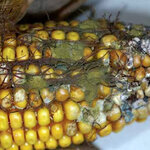Technology

There are many pests in the world which attack plants or compete with them for the resources they need to grow. This is true for plants growing in natural stands, but also for the plants that people grow as crops. If pests are left unchecked, crop productivity is compromised.
Without good pest control, it would take a lot more land to feed humanity - land we simply don't have. Pest damage can also compromise the storage or shelf-life of foods leading to more wasteful inefficiencies. Pests can also make foods dangerous through the production of mycotoxins (see contaminated corn…
If you are an avid gamer who can't be bothered with cooking Christmas dinner, or a hipster who wants to cynically consume packaged food while watching bad movies, there is a good news.
The Christmas Tinner is 9 layers of processed food in a can, meals to cover the entire day - including breakfast, turkey and even Christmas pudding. There’s even a broccoli alternative if the sprouts are the worst thing you can find in this idea.
Kingston University third-year graphic designer Chris Godfrey processed the food and sealed it with gelatin, placing each layer in the tin one at a time. All the gamer…

Combining two innovative technologies, a team of engineers have made steps toward a better recipe for synthetic replacement cartilage in joints. Farshid Guilak, a professor of orthopedic surgery and biomedical engineering at Duke University, and Xuanhe Zhao, assistant professor of mechanical engineering and materials science, found a way to create artificial replacement tissue that mimics both the strength and suppleness of natural cartilage.
Articular cartilage is the tissue on the ends of bones where they meet at joints in the body – including in the knees, shoulders and hips. It…

Peer-reviewed articles are taking off on Twitter - whether or not people have read them is another story.
But someone read them during peer review so more exposure is good even if, in the case of legacy journals, people can only read the abstract.
Stefanie Haustein, of the University of Montreal's School of Library and Information Science, and colleagues looked at the most tweeted peer-reviewed articles published between 2010 and 2012 They took 1.4 million articles held in the PubMed and Web of Science databases and determined how many times they appeared on Twitter. "Being based…

Microscopy is the universal diagnostic method for detection of most globally important parasitic infections.
But it's not cheap. Methods developed in well-equipped laboratories are not available at the basic levels of the health care system due to lack of resources. Researchers at the Institute for Molecular Medicine Finland, FIMM, University of Helsinki and Karolinska Institutet, Sweden, have now shown that novel techniques for high-resolution imaging and image transfer over data networks may be utilized to solve these diagnostic problems.
The team modified inexpensive imaging devices…

The image of robotics in popular culture is classic science fiction; cogwheels, pistons and levers with perhaps a layer of rubberized skin: miniaturized robots of the future will be "soft".
"If I think of the robots of tomorrow, what comes to mind are the tentacles of an octopus or the trunk of an elephant rather than the mechanical arm of a crane or the inner workings of a watch. And if I think of micro-robots then I think of unicellular organisms moving in water. The robots of the future will be increasingly like biological organisms," explains Antonio De Simone of
International…

Fish is good for you. While fish farming takes hold, the legacy way of providing fish, boats and nets, is still in use. But in most parts of the world, it's hard to know how much fish is being caught, and that makes it difficult to engage in proper resource management or justify farmed fish.
Google Earth may be here to help.
Large fish traps in the Persian Gulf could be catching up to six times more fish than what's being officially reported, according to the first investigation of fish catches from space conducted by University of British Columbia scientists.
Using satellite imagery from…

Researchers have built a small vehicle whose flying motion resembles the movements of those boneless, pulsating, water-dwelling creatures we call jellyfish.
Their presentation at the American Physical Society's Division of Fluid Dynamics meeting in Pittsburgh,demonstrates a new method of flight that could transport miniaturized future robots for surveillance, search-and-rescue, and monitoring of the atmosphere and traffic.
Many approaches to building small aerial robots try to mimic the flight of insects such as fruit flies. The challenge in that, explained Leif Ristroph of New…

Spontaneous bursts of light,
which last trillionths of a second, change color as they pulse from within a solid-state block
and illuminate the unusual way interacting quantum particles behave when they are driven far from equilibrium. A way to trigger these flashes may lead to new telecommunications equipment and other devices that transmit signals at picosecond speeds.
The Rice University lab of Junichiro Kono said the phenomenon can be understood as a combination of two previously known many-body concepts: superfluorescence, as seen in atomic and molecular systems, and Fermi-edge…

A $500
three-dimensional
"nano-camera" that can operate at the speed of light has been developed by researchers in the MIT Media Lab and was presented at Siggraph Asia in Hong Kong. It could be used in medical imaging and collision-avoidance detectors for cars, and to improve the accuracy of motion tracking and gesture-recognition devices used in interactive gaming.
The camera is based on "Time of Flight" technology like that used in Microsoft's recently launched second-generation Kinect device, in which the location of objects is calculated by how long it takes a light signal to…